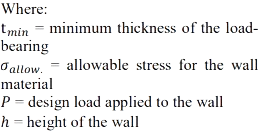LOAD BEARING WALLS

1. MAXIMUM ALLOWABLE LOAD :
The design of load-bearing walls requires calculating the maximum allowable load the wall can support, given by the equation:


2. MINIMUM WALL THICKNESS :
Minimum thickness of a load-bearing wall is based on the allowable stress, the design load, and the height of the wall. It can be expressed as:

3. SPAN :
The span of a brick wall, referring to the distance between its supports, is influenced by several factors:- The type and thickness of bricks, mortar strength, wall height, the loads it needs to bear. For load-bearing brick walls, the maximum recommended span is typically about 6 to 7 times the wall thickness. Beyond this span, additional support such as columns or piers may be required to prevent excessive deflection and instability.

4. LATERAL STABILITY :
The lateral stability of load-bearing walls ensuring resistance to horizontal forces like wind or seismic loads. Design approaches include shear walls, bracing systems, or diaphragms. Their effectiveness depends on factors such as wall height, stiffness, and material properties. The equation for calculating the force in a shear wall is:

5. REINFORCEMENT DESIGN :
In reinforced design for load-bearing walls, the capacity to withstand vertical and lateral loads is enhanced by adding
reinforcement. The design process involves determining the required amount and placement of reinforcement based on structural analysis and design codes.

In conclusion, designing load-bearing walls involves careful consideration of several key factors. These include determining the maximum allowable load, establishing the minimum wall thickness, designing appropriate reinforcement, determining the design span, and ensuring adequate lateral stability. These elements are crucial to ensuring the structural integrity and safety of load-bearing walls in a building. By adhering to these principles, engineers can create load-bearing walls that effectively support the loads they are designed to carry, contributing to the overall stability and safety of the structure.

